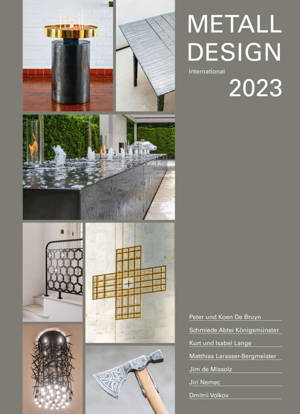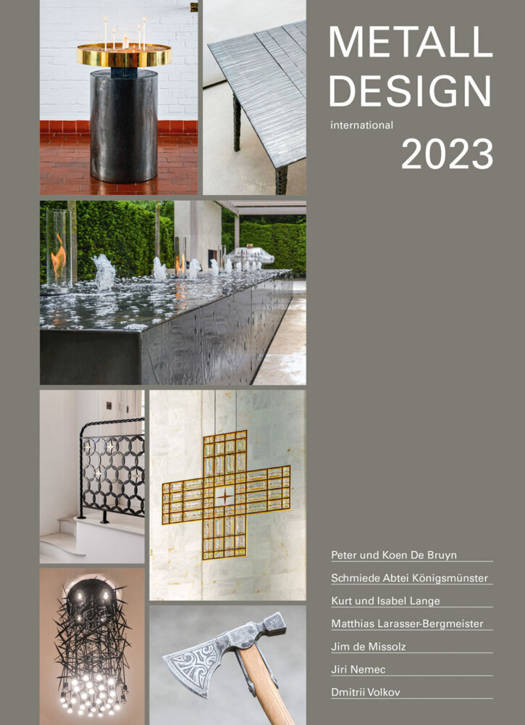
- Afhalen na 1 uur in een winkel met voorraad
- Gratis thuislevering in België vanaf € 30
- Ruim aanbod met 7 miljoen producten
- Afhalen na 1 uur in een winkel met voorraad
- Gratis thuislevering in België vanaf € 30
- Ruim aanbod met 7 miljoen producten
Zoeken
MetallDesign international. Hephaistos-Jahrbuch / MetallDesign international 2023
Ilka Schöning, Josef Moos, Lisa Hartmann
€ 44,45
+ 88 punten
Omschrijving
Master blacksmith and sculptor Matthias Larasser-Bergmeister (Germany) can look back on a successful period of productive work - and he is still active and successful. He learned the blacksmith's craft from the renowned master craftsmen Manfred Bergmeister and German Larasser. Before taking his master's examination, he went to Dick Quinell in England and then studied at the Academy of Fine Arts in Munich until he obtained his sculptor diploma. His oeuvre is wide-ranging, designing and making contemporary furniture, grilles, gates and railings as well as trend-setting church furnishings.Dmitrii Volkov was born in 1972 in St. Petersburg, Russia. He now lives and works in the USA. As a blacksmith and sculptor, he has been primarily making art objects since 1996. He designs and makes sculptures and jewelry from steel, silver, copper, bronze, wood and glass. But his portfolio also includes artfully designed objects of daily use. Each work - its execution, its effect, its position in the overall structure - is thought through down to the last detail with extraordinary sensitivity. Volkov likes to compare objects to people: Partially imperfect, but constantly striving for perfection.What can be the design-craft profile of a monastery forge? This is a question that Fr Abraham, head of the monastery smithy at Königsmünster Abbey (Germany), often asks himself. After his theology studies, he had begun training in the monastery's own blacksmith's workshop and took over its management after passing his master's examination in 2006. At present, the workshop team consists of eight people. The boundaries between pastoral care, theology and craftsmanship as well as design always open up new subject areas, such as contemporary religious signs, modern grave design or church furnishings. Jim de Missolz is often called the "last blacksmith of Paris", and indeed he has mastered some craftsmanship skills that have become rare in his native France. A locksmith and metalworker, he specializes in fine metalwork and offers exceptional fittings for interior designers, ministries, public buildings, private individuals as well as companies. The thirty-something's business in a listed building has been awarded a Living Heritage label by the Ministry of Finance. De Missolz's skills are recognized throughout France.In 1991, at the age of 23, Peter De Bruyn started building his own blacksmith's workshop in Erembodegem, Belgium. In 2006, his son Koen De Bruyn also joined the forge. There, the two of them and their team carry out a wide variety of work with a remarkable sense of style. In recent years, the focus has been on the production of railings in a wide variety of shapes, as well as contemporary artistic wrought-iron work and restorations. In the workshop, all available modern techniques are used, but also traditional ones.Kurt Lange's heart belongs to the untreated surface, which is allowed to take on a natural patina. In the eyes of the German, rust is not an enemy of matter, but its necessary companion. He has no claim to eternity; he allows nature its right to appropriate his work chemically. His wife Isabel Lange encodes the messages of her sculptures through two states: steel present, steel removed. A graphic principle, related to letterpress and complemented by the third dimension. She makes heavy things light when she perforates her iron plates, leaving only fine webs. Jiri Nemec has been running a forge workshop in the Czech Republic since 2007. Stylistically, he has a great affinity with Art Nouveau, and he is still strongly influenced by the work of Claudio Bottero, Gabriele Curtolo, Pavel Tasovsky and Karel Bures. He uses traditional techniques such as open and close die forging and combines them with the new technologies of welding, plasma cutting, hydraulic pressing, etc. One of his hobbies is making axes and tomahawks, which he designs himself. He has already won several awards at the Hefaiston at Helfstyn Castle.
Specificaties
Betrokkenen
- Auteur(s):
- Uitgeverij:
Inhoud
- Aantal bladzijden:
- 232
- Taal:
- Engels, Duits
- Reeks:
- Reeksnummer:
- nr. 25
Eigenschappen
- Productcode (EAN):
- 9783958051010
- Verschijningsdatum:
- 29/11/2022
- Uitvoering:
- Hardcover
- Afmetingen:
- 211 mm x 22 mm
- Gewicht:
- 1108 g

Alleen bij Standaard Boekhandel
+ 88 punten op je klantenkaart van Standaard Boekhandel
Beoordelingen
We publiceren alleen reviews die voldoen aan de voorwaarden voor reviews. Bekijk onze voorwaarden voor reviews.











